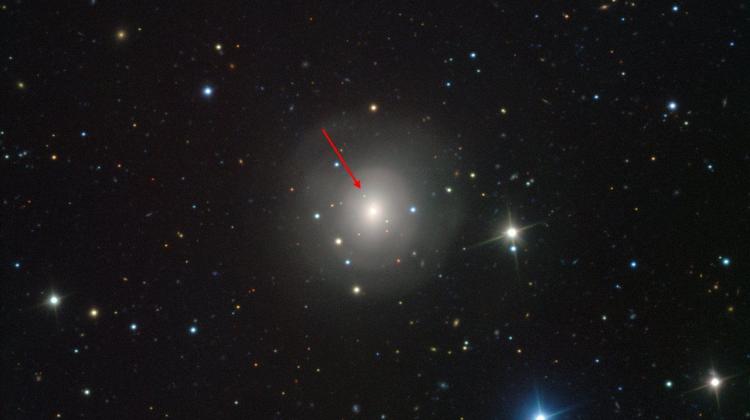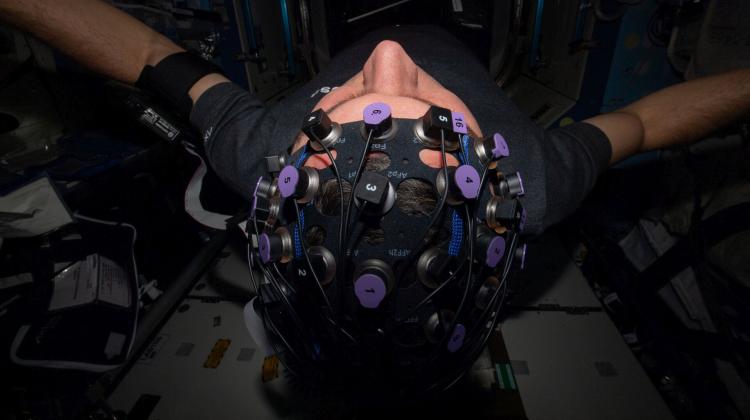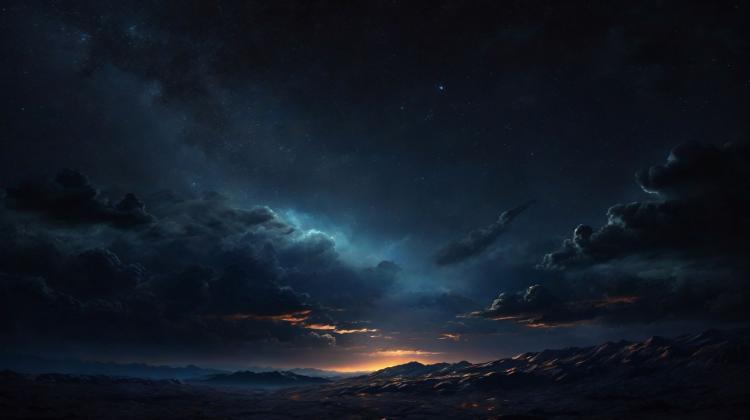Gravitational waves from colliding neutron stars detected for the first time
 The image of the galaxy NGC 4993 shows the visible-light counterpart to a merging neutron star pair GW170817 (indicated with the arrow). The image taken with the VIMOS instrument on ESO’s Very Large Telescope at the Paranal Observatory in Chile. Source: ESO.
The image of the galaxy NGC 4993 shows the visible-light counterpart to a merging neutron star pair GW170817 (indicated with the arrow). The image taken with the VIMOS instrument on ESO’s Very Large Telescope at the Paranal Observatory in Chile. Source: ESO.
Astronomers for the first time simultaneously registered two types of waves: gravitational and electromagnetic waves originating from one phenomenon - a collision of two neutron stars. Polish researchers participated in observations conducted by research teams around the world.
In February, the scientific world was shaken by the news of the first historical detection of gravitational waves - wrinkles in space-time, predicted by Albert Einstein\'s general relativity theory. Those waves were the echoes of merging of two black holes, 1.3 billion light-years from Earth. The confirmation of the existence of these waves was considered a revolution in astrophysics. The first detection (in September 2015) was later confirmed.
On Monday, October 16, researchers reported another important observation: simultaneous detection of gravitational waves and their electromagnetic counterpart, including visible light, coming from the same source.
This is already the 5th confirmed detection of gravitational waves, but this detection is different from the previous ones. Previous detections were related to collisions of two black holes, this time, for the first time, source of the phenomenon is the collision of two neutron stars.
The collision occurred probably 130 million light-years from Earth, in the galaxy NGC 4993. This means that astronomers are dealing with the nearest source of gravitational waves detected to date. It is also one of the nearest registered gamma-ray bursts.
However, had the source been further away, the phenomenon would probably escape the LIGO detectors, since it turned out to be generated by a collision of two neutron stars, which generates a much weaker signal than a collision of black holes.
An indication that this time it was not a merger of black holes, were the characteristics of the so-called "chirp" just before the collision of objects. In the case of black holes, the chirp lasts a fraction of a second, and in the case of the August 17th event, it continued for almost 2 minutes. The masses of colliding objects were estimated at 1.1 and 1.6 solar masses, which clearly suggests neutron stars - very dense objects with diameters of approx. 20 kilometres, where the matter is so dense that one teaspoon of it can weigh billions of tons.
Merger of two neutron stars is a leading hypothesis explaining short gamma-ray bursts. According to the theory, in the case of two neutron stars merging, an explosion 1000 times brighter than a nova should also occur, so this phenomenon is termed "kilonova". Detection of GW170817 simultaneously in gravitational and electromagnetic waves supports this hypothesis. Scientists believe they have finally managed to observe a kilonova. The existence of kilonovae has been suggested theoretically for more than 30 years.
Kilonovae can be the main events responsible for the propagation of very heavy chemical elements in space, including gold and platinum. During an explosion, they are ejected at a rate of one fifth of the speed of light. Spectra obtained by scientists show the presence of caesium and tellurium in the ejected matter.
According to researchers, the simultaneous detection of gravitational waves and their electromagnetic counterpart (including visible light) from the same source heralds a new era in space research known as "multimessenger astrophysics".
The detection involved more than 70 laboratories and on every continent, both ground and space observatories.
The gravitational wave signal was registered on August 17, 2017 at 14:41 CEST by twin LIGO detectors, located in Hanford, Washington, and in Livingston, Louisiana. This event received designation GW170817. This is already the fifth confirmed detection of gravitational waves, but different from the previous ones, because the previous four detections were related to collisions of two black holes, and this time, for the first time, source of the phenomenon is the collision of two neutron stars
LIGO observatories detected gravitational waves, and the Virgo Observatory made it possible to narrow down the area of the sky from which the signal originated. This area is estimated at about 35 square degrees, i.e. a few hundred full moon shields. At that point, the observatories designed to study electromagnetic waves in different wavelength ranges took over, combing the sky in search of an electromagnetic counterpart of the source of gravitational waves.
First, a real-time special LIGO data analysis procedure detected a gravitational wave signal in one of the detectors. About two seconds after LIGO\'s detection, space observatories Fermi and INTEGRAL (the former of NASA, the latter of the European Space Agency) recorded a short gamma-ray burst from the same area of the sky. Reserachers determined that those two detections were not coincidental. Then another automated data analysis procedure alerted the researchers that the second LIGO detector had also registered the signal. At that point, telescope observations started all over the world.
The European Southern Observatory (ESO), which Poland belongs to, launched one of the largest ever "target of opportunity" search campaigns, searching for the counterpart of gravitational waves in multiple wavelengths of electromagnetic waves. Infrared VISTA telescope was one of the first to spot an optical counterpart of the source of gravitational waves. Other ESO telescopes, such as the Very Large Telescope (VLT), VST telescope, NTT telescope, ALMA telescope and other ESO observatories were also used. These instruments tracked the object for days and weeks after detection.
As the night moved around the globe, observations were conducted by further astronomical observatories, for example, among the instruments operating in Hawaii, Pan-STARRS and Subaru telescopes spotted the source and then followed its evolution. Observations were also conducted from space, for example through the Hubble Space Telescope.
Researchers from various Polish centers, as well as Polish researchers working abroad, participated in the discovery and observations. This applies in particular to the researchers in the Virgo-POLGRAW team led by Prof. Andrzej Królak from the Institute of Mathematics of the Polish Academy of Sciences.
In the case of the Astronomical Observatory of the University of Warsaw, Prof. Tomasz Bulik is a member of the LIGO/VIRGO team, and Dr. Łukasz Wyrzykowski with co-workers: Dr. Mariusz Gromadzki and PhD students Krzysztof Rybicki and Aleksandra Hamanowicz, conducted visible light emission studies using the SALT telescopes in South Africa and NTT in the Southern European Observatory (ESO) in Chile as part of the international ePESSTO team. The galaxy NGC 4993, where the neutron stars merged, was also observed by the OGLE team led by Prof. Andrzej Udalski.
Also involved was the Polish project Pi of the Sky, implemented by the Faculty of Physics of the University of Warsaw, the National Centre for Nuclear Research and the Center for Theoretical Physics of the Polish Academy of Sciences, The main objective of the project is to search for optical flashes accompanying gamma-ray bursts. The project\'s robotic telescope operating in Spain was one of the first to begin searching for the optical emissions accompanying GW170817. More than half of the sky area indicated by LIGO was within the range of the telescope. No new object was detected in the sky in the telescope\'s range (up to magnitude 12), and it ultimately turned out that the location of source GW170817 was invisible to that telescope.
Another project with Polish participation is the HAWC gamma-ray observatory in Mexico. GW170817 entered the HAWC\'s field of vision only about 9 hours after the detection of gravitational waves. Observations of the area were conducted for over 2 hours, but at that point the source was at the edge of the field of vision. No gamma rays were registered, but this allowed to determine the upper limit of the stream of gamma photons that could reach us from the source.
Scientific publications of various research groups concerning the observation have appeared in the "Nature", "Physical Review Letters", "Astrophysical Journal Letters" and "Monthly Notices of the Royal Astronomical Society". Among the authors there are several Polish names.
It is worth recalling that this year\'s Nobel Prize in Physics was awarded for the contribution to the detection of gravitational waves. (PAP)
cza/ zan/ kap/
tr. RL
Przed dodaniem komentarza prosimy o zapoznanie z Regulaminem forum serwisu Nauka w Polsce.

















